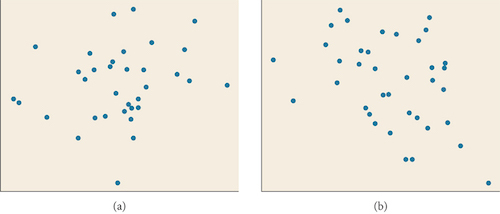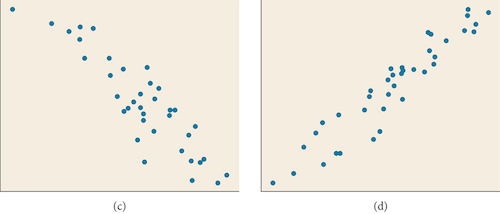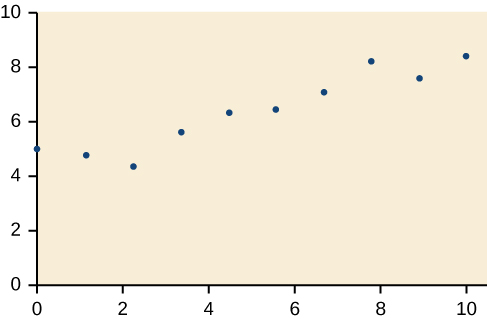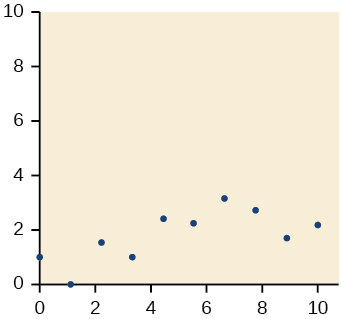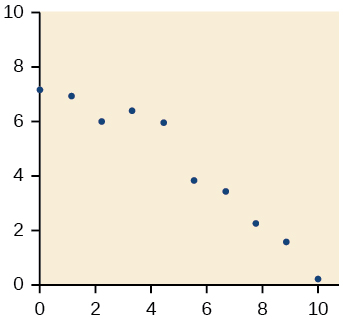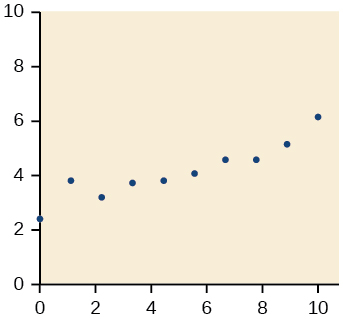2.4 Modeling with Linear Functions
2.4 Fitting Linear Models to Data
Learning Objectives
In this section, you will:
- Draw and interpret scatter plots.
- Find the line of best fit.
- Distinguish between linear and nonlinear relations.
- Use a linear model to make predictions.
A professor is attempting to identify trends among final exam scores. His class has a mixture of students, so he wonders if there is any relationship between age and final exam scores. One way for him to analyze the scores is by creating a diagram that relates the age of each student to the exam score received. In this section, we will examine one such diagram known as a scatter plot.
Drawing and Interpreting Scatter Plots
A scatter plot is a graph of plotted points that may show a relationship between two sets of data. If the relationship is from a linear model, or a model that is nearly linear, the professor can draw conclusions using his knowledge of linear functions. Figure 1 shows a sample scatter plot.
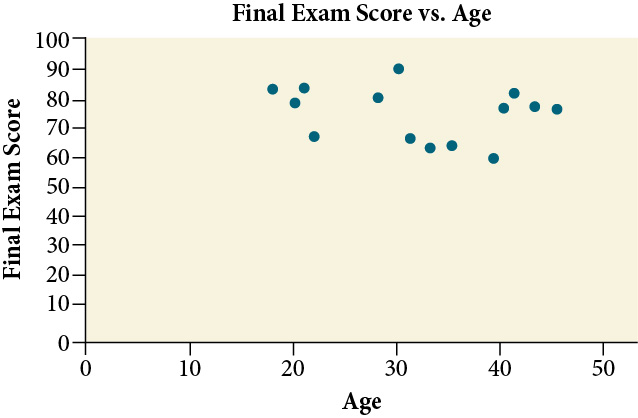
Notice this scatter plot does not indicate a linear relationship. The points do not appear to follow a trend. In other words, there does not appear to be a relationship between the age of the student and the score on the final exam.
Example 1: Using a Scatter Plot to Investigate Cricket Chirps
The table below shows the number of cricket chirps in 15 seconds, for several different air temperatures, in degrees Fahrenheit4. Plot this data, and determine whether the data appears to be linearly related.
4
Selected data from http://classic.globe.gov/fsl/scientistsblog/2007/10/. Retrieved Aug 3, 2010
| Units | Time 1 | Time 2 | Time 3 | Time 4 | Time 5 | Time 6 | Time 7 | Time 8 | Time 9 |
|---|---|---|---|---|---|---|---|---|---|
| Chirps | 44 | 35 | 20.4 | 33 | 31 | 35 | 18.5 | 37 | 26 |
| Temperature | 80.5 | 70.5 | 57 | 66 | 68 | 72 | 52 | 73.5 | 53 |
Show Solution
Plotting this data, as depicted in Figure 2 suggests that there may be a trend. We can see from the trend in the data that the number of chirps increases as the temperature increases. The trend appears to be roughly linear, though certainly not perfectly so.
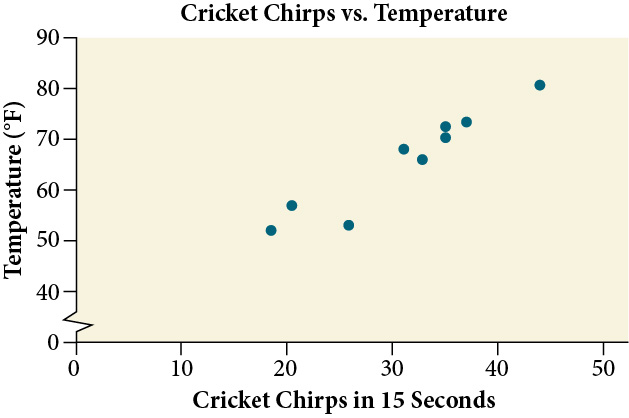
Finding the Line of Best Fit
Once we recognize a need for a linear function to model that data, the natural follow-up question is “what is that linear function?” One way to approximate our linear function is to sketch the line that seems to best fit the data. Then we can extend the line until we can verify the y-intercept. We can approximate the slope of the line by extending it until we can estimate the [latex]\large\frac{\text{rise}}{\text{run}}[/latex].
Example 2: Finding a Line of Best Fit
Find a linear function that fits the data in Table 1 by “eyeballing” a line that seems to fit.
Show Solution
On a graph, we could try sketching a line. Using the starting and ending points of our hand drawn line, points (0, 30) and (50, 90), this graph has a slope of
[latex]\begin{aligned} m & =\frac{60}{50} \\ & =1.2 \end{aligned}[/latex]
and a y-intercept at 30. This gives an equation of
[latex]T(c)=1.2c+30[/latex]
where [latex]c[/latex] is the number of chirps in 15 seconds, and [latex]T(c)[/latex] is the temperature in degrees Fahrenheit. The resulting equation is represented in Figure 3
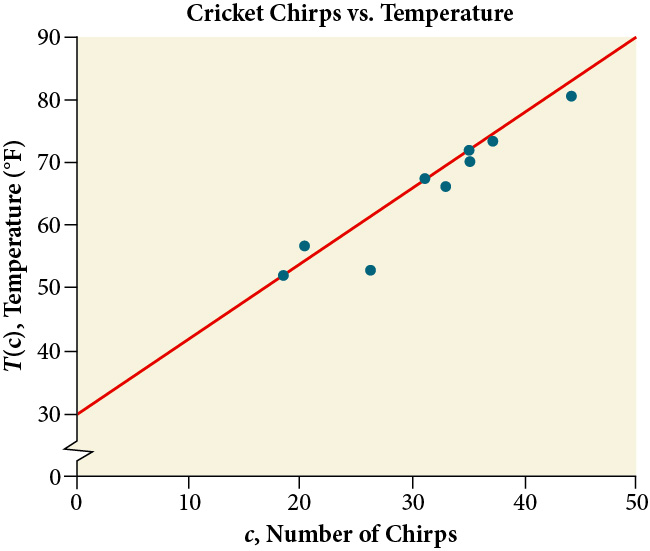
Analysis
This linear equation can then be used to approximate answers to various questions we might ask about the trend.
Recognizing Interpolation or Extrapolation
While the data for most examples does not fall perfectly on the line, the equation is our best guess as to how the relationship will behave outside of the values for which we have data. We use a process known as interpolation when we predict a value inside the domain and range of the data. The process of extrapolation is used when we predict a value outside the domain and range of the data.
Figure 4 compares the two processes for the cricket-chirp data addressed in Example 2. We can see that interpolation would occur if we used our model to predict temperature when the values for chirps are between 18.5 and 44. Extrapolation would occur if we used our model to predict temperature when the values for chirps are less than 18.5 or greater than 44.
There is a difference between making predictions inside the domain and range of values for which we have data and outside that domain and range. Predicting a value outside of the domain and range has its limitations. When our model no longer applies after a certain point, it is sometimes called model breakdown. For example, predicting a cost function for a period of two years may involve examining the data where the input is the time in years and the output is the cost. But if we try to extrapolate a cost when x=50, that is in 50 years, the model would not apply because we could not account for factors fifty years in the future.
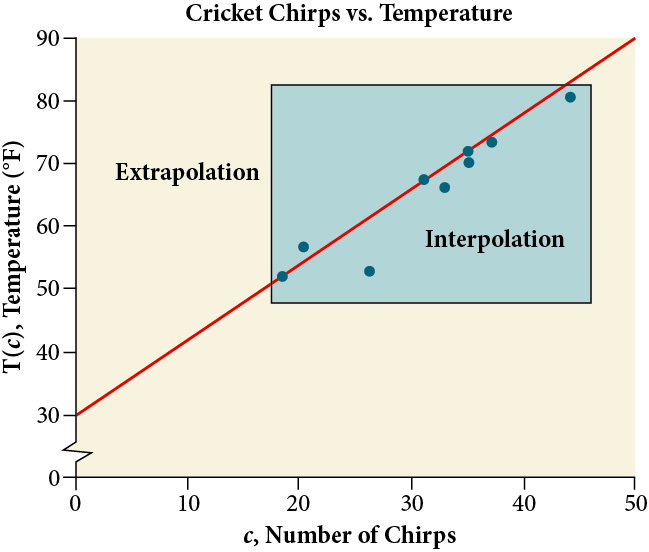
Example 3: Understanding Interpolation and Extrapolation
Use the cricket data from Table 1 to answer the following questions:
- Would predicting the temperature when crickets are chirping 30 times in 15 seconds be interpolation or extrapolation? Make the prediction, and discuss whether it is reasonable.
- Would predicting the number of chirps crickets will make at 40 degrees be interpolation or extrapolation? Make the prediction, and discuss whether it is reasonable.
Would predicting the number of chirps crickets will make at 40 degrees be interpolation or extrapolation? Make the prediction, and discuss whether it is reasonable.
Show Solution
- The number of chirps in the data provided varied from 18.5 to 44. A prediction at 30 chirps per 15 seconds is inside the domain of our data, so would be interpolation. Using our model:
[latex]\begin{array}{c} T(30)=30+1.2(30) \\ =66 \text { degrees } \end{array}[/latex]
Based on the data we have, this value seems reasonable.
- The temperature values varied from 52 to 80.5. Predicting the number of chirps at 40 degrees is extrapolation because 40 is outside the range of our data. Using our model:
We can compare the regions of interpolation and extrapolation using Figure 5.
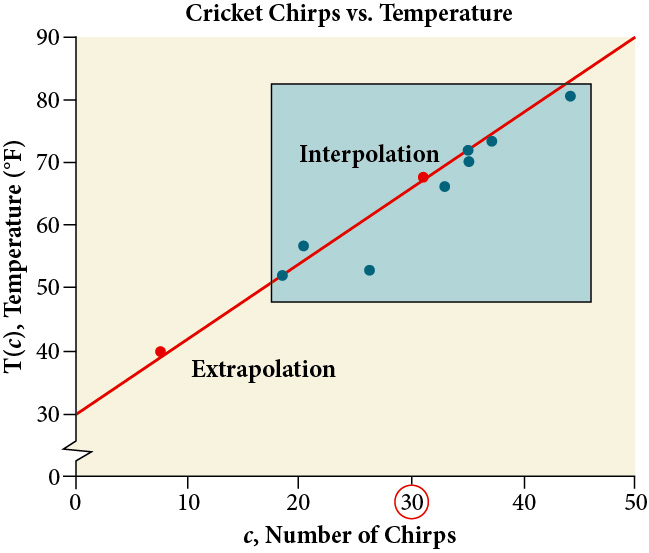
Analysis
Our model predicts the crickets would chirp 8.33 times in 15 seconds. While this might be possible, we have no reason to believe our model is valid outside the domain and range. In fact, generally crickets stop chirping altogether below around 50 degrees.
Try It #1
According to the data from Table 1, what temperature can we predict it is if we counted 20 chirps in 15 seconds?
Finding the Line of Best Fit Using a Graphing Utility
While eyeballing a line works reasonably well, there are statistical techniques for fitting a line to data that minimize the differences between the line and data values5. One such technique is called least squares regression and can be computed by many graphing calculators, spreadsheet software, statistical software, and many web-based calculators6. Least squares regression is one means to determine the line that best fits the data, and here we will refer to this method as linear regression.
Technically, the method minimizes the sum of the squared differences in the vertical direction between the line and the data values.
For example, Linear Least Squares Regression
How To
Given data of input and corresponding outputs from a linear function, find the best fit line using linear regression.
Enter the input in List 1 (L1).
Enter the output in List 2 (L2).
On a graphing utility, select Linear Regression (LinReg).
Example 4: Finding a Least Squares Regression Line
Find the least squares regression line using the cricket-chirp data in Table 1.
Show Solution
- Enter the input (chirps) in List 1 (L1).
- Enter the output (temperature) in List 2 (L2). See Table 2.
| Units | Time 1 | Time 2 | Time 3 | Time 4 | Time 5 | Time 6 | Time 7 | Time 8 | Time 9 |
|---|---|---|---|---|---|---|---|---|---|
| Chirps | 44 | 35 | 20.4 | 33 | 31 | 35 | 18.5 | 37 | 26 |
| Temperature | 80.5 | 70.5 | 57 | 66 | 68 | 72 | 52 | 73.5 | 53 |
Table 2
- On a graphing utility, select Linear Regression (LinReg). Using the cricket chirp data from earlier, with technology we obtain the equation:
Analysis
Notice that this line is quite similar to the equation we “eyeballed” but should fit the data better. Notice also that using this equation would change our prediction for the temperature when hearing 30 chirps in 15 seconds from 66 degrees to:
[latex]\begin{array}{c} T(30)=30.281+1.143(30) \\ =64.571 \\ \approx 64.6 \text { degrees } \end{array}[/latex]
The graph of the scatter plot with the least squares regression line is shown in Figure 6.
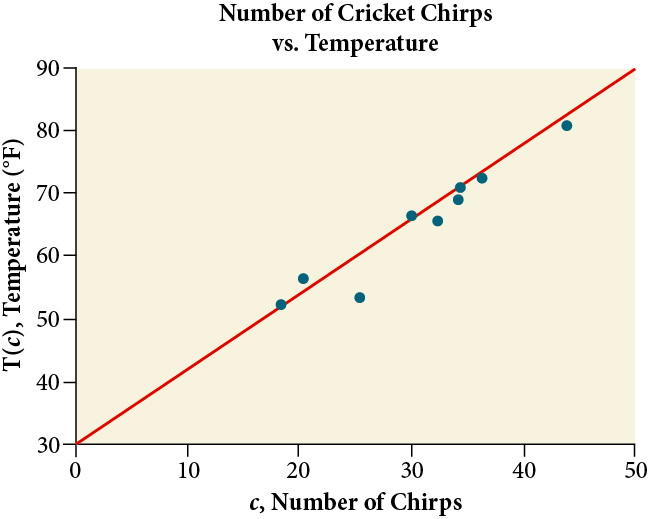
Q&A
Will there ever be a case where two different lines will serve as the best fit for the data?
No. There is only one best fit line.
Distinguishing Between Linear and Non-Linear Models
As we saw above with the cricket-chirp model, some data exhibit strong linear trends, but other data, like the final exam scores plotted by age, are clearly nonlinear. Most calculators and computer software can also provide us with the correlation coefficient, which is a measure of how closely the line fits the data. Many graphing calculators require the user to turn a ”diagnostic on” selection to find the correlation coefficient, which mathematicians label as [latex]r[/latex]. The correlation coefficient provides an easy way to get an idea of how close to a line the data falls.
We should compute the correlation coefficient only for data that follows a linear pattern or to determine the degree to which a data set is linear. If the data exhibits a nonlinear pattern, the correlation coefficient for a linear regression is meaningless. To get a sense for the relationship between the value of [latex]r[/latex] and the graph of the data, Figure 7 shows some large data sets with their correlation coefficients. Remember, for all plots, the horizontal axis shows the input and the vertical axis shows the output.
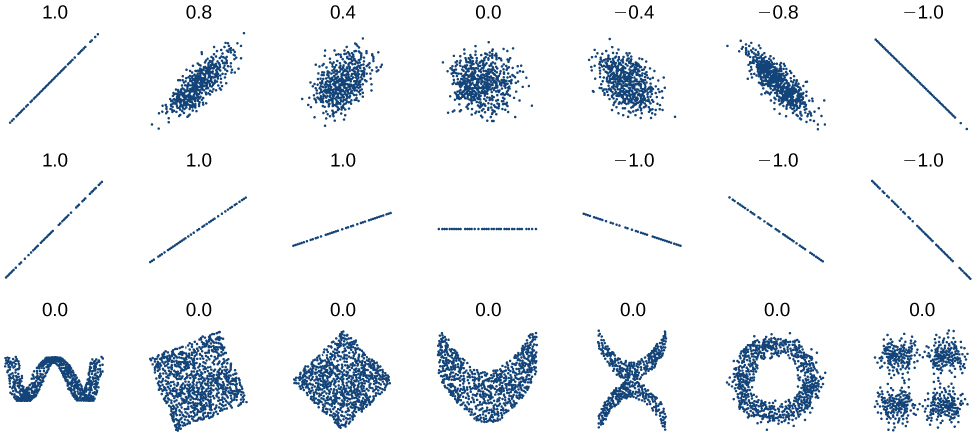
Correlation Coefficient
The correlation coefficient is a value, [latex]r[/latex], between –1 and 1.
- [latex]r > 0[/latex] suggests a positive (increasing) relationship
- [latex]r < 0[/latex] suggests a negative (decreasing) relationship
- The closer the value is to 0, the more scattered the data.
- The closer the value is to 1 or –1, the less scattered the data is.
Example 5: Finding a Correlation Coefficient
Calculate the correlation coefficient for cricket-chirp data in Table 1.
Show Solution
Because the data appear to follow a linear pattern, we can use technology to calculate [latex]r[/latex]. Enter the inputs and corresponding outputs and select the Linear Regression. The calculator will also provide you with the correlation coefficient [latex]r=0.9509[/latex].
This value is very close to 1, which suggests a strong increasing linear relationship.
Note: For some calculators, the Diagnostics must be turned "on" in order to get the correlation coefficient when linear regression is performed: [2nd]>[0]>[alpha][x–1], then scroll to DIAGNOSTICSON.
Predicting with a Regression Line
Once we determine that a set of data is linear using the correlation coefficient, we can use the regression line to make predictions. As we learned above, a regression line is a line that is closest to the data in the scatter plot, which means that only one such line is a best fit for the data.
Example 6: Using a Regression Line to Make Predictions
Gasoline consumption in the United States has been steadily increasing. Consumption data from 1994 to 2004 is shown in Table 37. Determine whether the trend is linear, and if so, find a model for the data. Use the model to predict the consumption in 2008.
7
http://www.bts.gov/publications/national_transportation_statistics/2005/html/table_04_10.html
|
Year |
'94 |
'95 |
'96 |
'97 |
'98 |
'99 |
'00 |
'01 |
'02 |
'03 |
'04 |
|---|---|---|---|---|---|---|---|---|---|---|---|
|
Consumption (billions of gallons) |
113 |
116 |
118 |
119 |
123 |
125 |
126 |
128 |
131 |
133 |
136 |
The scatter plot of the data, including the least squares regression line, is shown in Figure 8.
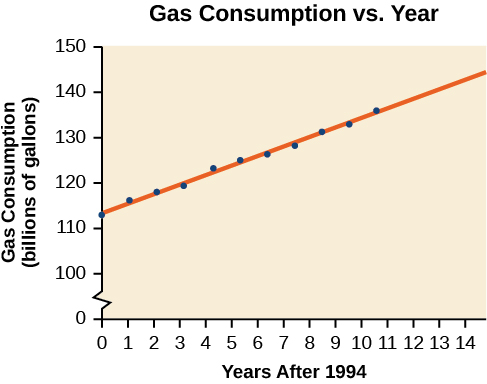
Show Solution
We can introduce new input variable, [latex]t[/latex], representing years since 1994.
The least squares regression equation is:
[latex]C(t)=113.318+2.209t[/latex]
Using technology, the correlation coefficient was calculated to be 0.9965, suggesting a very strong increasing linear trend.
Using this to predict consumption in 2008 [latex](t=14)[/latex],
[latex]\begin{array}{c} C(14)=113.318+2.209(14) \\ =144.244 \end{array}[/latex]
The model predicts 144.244 billion gallons of gasoline consumption in 2008.
Try It #2
Use the model we created using technology in Example 6 to predict the gas consumption in 2011. Is this an interpolation or an extrapolation?
Access these online resources for additional instruction and practice with fitting linear models to data.
Introduction to Regression Analysis
2.4 Section Exercises
Verbal
1.
Describe what it means if there is a model breakdown when using a linear model.
2.
What is interpolation when using a linear model?
3.
What is extrapolation when using a linear model?
4.
Explain the difference between a positive and a negative correlation coefficient.
5.
Explain how to interpret the absolute value of a correlation coefficient.
Algebraic
6.
A regression was run to determine whether there is a relationship between hours of TV watched per day
and number of sit-ups a person can do
The results of the regression are given below. Use this to predict the number of sit-ups a person who watches 11 hours of TV can do.

7.
A regression was run to determine whether there is a relationship between the diameter of a tree (
in inches) and the tree’s age (
in years). The results of the regression are given below. Use this to predict the age of a tree with diameter 10 inches.

For the following exercises, draw a scatter plot for the data provided. Does the data appear to be linearly related?
8.
|
0 |
2 |
4 |
6 |
8 |
10 |
|
–22 |
–19 |
–15 |
–11 |
–6 |
–2 |
9.
|
1 |
2 |
3 |
4 |
5 |
6 |
|
46 |
50 |
59 |
75 |
100 |
136 |
10.
|
100 |
250 |
300 |
450 |
600 |
750 |
|
12 |
12.6 |
13.1 |
14 |
14.5 |
15.2 |
11.
|
1 |
3 |
5 |
7 |
9 |
11 |
|
1 |
9 |
28 |
65 |
125 |
216 |
12.
For the following data, draw a scatter plot. If we wanted to know when the population would reach 15,000, would the answer involve interpolation or extrapolation? Eyeball the line, and estimate the answer.
|
Year |
Population |
|
1990 |
11,500 |
|
1995 |
12,100 |
|
2000 |
12,700 |
|
2005 |
13,000 |
|
2010 |
13,750 |
13.
For the following data, draw a scatter plot. If we wanted to know when the temperature would reach 28 °F, would the answer involve interpolation or extrapolation? Eyeball the line and estimate the answer.
|
Temperature, °F |
16 |
18 |
20 |
25 |
30 |
|
Time, seconds |
46 |
50 |
54 |
55 |
62 |
Graphical
For the following exercises, match each scatterplot with one of the four specified correlations in Figure 9 and Figure 10.
Figure 9
Figure 10
14.
r=0.95
15.
r=-0.89
16.
r=0.26
17.
r=-0.39
For the following exercises, draw a best-fit line for the plotted data.
18.
19.
20.
21.
Numeric
22.
The U.S. Census tracks the percentage of persons 25 years or older who are college graduates. That data for several years is given in Table 48. Determine whether the trend appears linear. If so, and assuming the trend continues, in what year will the percentage exceed 35%?
8
http://www.census.gov/hhes/socdemo/education/data/cps/historical/index.html. Accessed 5/1/2014.
|
Year |
Percent Graduates |
|
1990 |
21.3 |
|
1992 |
21.4 |
|
1994 |
22.2 |
|
1996 |
23.6 |
|
1998 |
24.4 |
|
2000 |
25.6 |
|
2002 |
26.7 |
|
2004 |
27.7 |
|
2006 |
28 |
|
2008 |
29.4 |
Table 4
23.
The U.S. import of wine (in hectoliters) for several years is given in Table 5. Determine whether the trend appears linear. If so, and assuming the trend continues, in what year will imports exceed 12,000 hectoliters?
|
Year |
Imports |
|
1992 |
2665 |
|
1994 |
2688 |
|
1996 |
3565 |
|
1998 |
4129 |
|
2000 |
4584 |
|
2002 |
5655 |
|
2004 |
6549 |
|
2006 |
7950 |
|
2008 |
8487 |
|
2009 |
9462 |
Table 5
24.
Table 6 shows the year and the number of people unemployed in a particular city for several years. Determine whether the trend appears linear. If so, and assuming the trend continues, in what year will the number of unemployed reach 5?
|
Year |
Number Unemployed |
|
1990 |
750 |
|
1992 |
670 |
|
1994 |
650 |
|
1996 |
605 |
|
1998 |
550 |
|
2000 |
510 |
|
2002 |
460 |
|
2004 |
420 |
|
2006 |
380 |
|
2008 |
320 |
Table 6
Technology
For the following exercises, use each set of data to calculate the regression line using a calculator or other technology tool, and determine the correlation coefficient to 3 decimal places of accuracy.
25.
|
x |
8 |
15 |
26 |
31 |
56 |
|
y |
23 |
41 |
53 |
72 |
103 |
26.
|
x |
5 |
7 |
10 |
12 |
15 |
|
y |
4 |
12 |
17 |
22 |
24 |
27.
|
x |
y |
x |
y |
|
3 |
21.9 |
11 |
15.76 |
|
4 |
22.22 |
12 |
13.68 |
|
5 |
22.74 |
13 |
14.1 |
|
6 |
22.26 |
14 |
14.02 |
|
7 |
20.78 |
15 |
11.94 |
|
8 |
17.6 |
16 |
12.76 |
|
9 |
16.52 |
17 |
11.28 |
|
10 |
18.54 |
18 |
9.1 |
28.
|
x |
y |
|
4 |
44.8 |
|
5 |
43.1 |
|
6 |
38.8 |
|
7 |
39 |
|
8 |
38 |
|
9 |
32.7 |
|
10 |
30.1 |
|
11 |
29.3 |
|
12 |
27 |
|
13 |
25.8 |
29.
|
x |
21 |
25 |
30 |
31 |
40 |
50 |
|
y |
17 |
11 |
2 |
-1 |
-18 |
-40 |
30.
|
x |
100 |
80 |
60 |
55 |
40 |
20 |
|
y |
2000 |
1798 |
1589 |
1580 |
1390 |
1202 |
31.
|
x |
900 |
988 |
1000 |
1010 |
1200 |
1205 |
|
y |
70 |
80 |
82 |
84 |
105 |
108 |
Extensions
32.
Graph
. Pick a set of 5 ordered pairs using inputs
and use linear regression to verify that the function is a good fit for the data.
33.
Graph
. Pick a set of 5 ordered pairs using inputs
and use linear regression to verify the function.
For the following exercises, consider this scenario: The profit of a company decreased steadily over a ten-year span. The following ordered pairs shows dollars and the number of units sold in hundreds and the profit in thousands of over the ten-year span, (number of units sold, profit) for specific recorded years:
.
34.
Use linear regression to determine a function
where the profit in thousands of dollars depends on the number of units sold in hundreds.
35.
Find to the nearest tenth and interpret the x-intercept.
36.
Find to the nearest tenth and interpret the y-intercept.
Real-World Applications
For the following exercises, consider this scenario: The population of a city increased steadily over a ten-year span. The following ordered pairs shows the population and the year over the ten-year span, (population, year) for specific recorded years:
(2500, 2000), (2650, 2001), (3000, 2003), (3500, 2006), (4200, 2010)
37.
Use linear regression to determine a function
where the year depends on the population. Round to three decimal places of accuracy.
38.
Predict when the population will hit 8,000.
For the following exercises, consider this scenario: The profit of a company increased steadily over a ten-year span. The following ordered pairs show the number of units sold in hundreds and the profit in thousands of over the ten year span, (number of units sold, profit) for specific recorded years:
.
39.
Use linear regression to determine a function y, where the profit in thousands of dollars depends on the number of units sold in hundreds .
40.
Predict when the profit will exceed one million dollars.
For the following exercises, consider this scenario: The profit of a company decreased steadily over a ten-year span. The following ordered pairs show dollars and the number of units sold in hundreds and the profit in thousands of over the ten-year span (number of units sold, profit) for specific recorded years:
(46, 250), (48, 225), (50, 205), (52, 180), (54, 165).
41.
Use linear regression to determine a function y, where the profit in thousands of dollars depends on the number of units sold in hundreds .
42.
Predict when the profit will dip below the $25,000 threshold.

